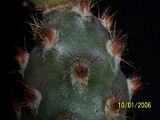Opuntia ficus-indica
* The joints of this cactus contain 6.840% water, 2.158% fat, 43.016% carbohydrate, 5.254% protein, 14.320% fiber and yield 28.412% ash.
The flamed (or microwaved) joints are split open and applied as a healing pad in cases of rheumatic and asthmatic symptoms of the chest, liver trouble, earaches, and tumors. A cataplasm is made from the fleshy joint and applied to the skin, externally, for cases of sun/windburn, minor rash/burn, hemorrhoids, snake/insect bites, and minor abrasions. An overnight infusion of the sliced, raw joints is consumed to treat eye inflammation, rabies, pimples, dysentery, and diarrhea. A sweetened infusion is drunk to lower fever and relieve chest pains. A decoction of cubed, peeled joints is drunk to relieve stomachache, and a root decoction was once used to treat gonorrhea.
The fruit (and seeds) are eaten raw, cooked, or preserved, in many countries worldwide. In Curacao, the pulp is infused (often with lime and sugar) and drunk all day, replacing water.
Also in Curacao and Puerto Rico, the pulp is used as a shampoo for hair, as well as added to whitewash as an adherent.
Farmers in Baja California, Mexico, remove the spines of this and other species of the genus Opuntia and feed it to their cattle. At the turn of the 19th century, this technique was experimented with on farms of Maui, Hawaii, but the seeds caused indigestion in the cows and were subsequently rejected.
excerpt
http://www.nybg.org/bsci/herb/cactaceae ... thnobotany










